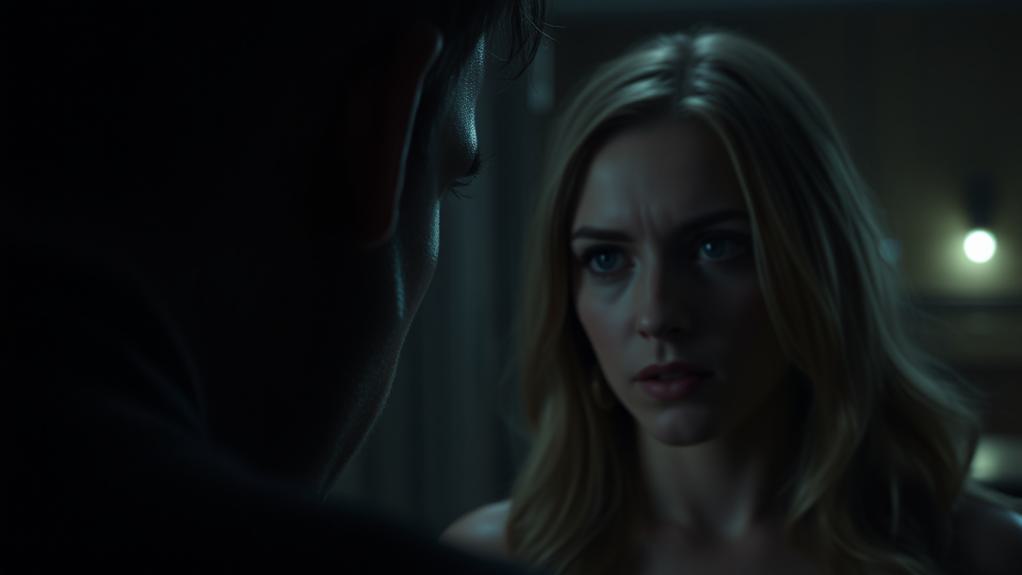Don't miss our holiday offer - up to 50% OFF!

He Keeps Staring at Me Even When I Catch Him – Here’s Why
When someone keeps staring at you even after you’ve caught them, it can leave you wondering why. Is it attraction, curiosity, or something else? It’s easy to feel flattered or uncomfortable, but not knowing their true intentions can be unsettling.
You might be thinking: Why does he keep staring? Should I do something about it? Maybe he’s interested, or perhaps he’s lost in thought. Understanding the reasons behind this behavior can help you navigate these mixed feelings and figure out how to respond confidently.
In this post, we’ll explore the possible reasons behind his gaze—whether it’s admiration, shyness, or simply a habit. By the end, you’ll have a clearer picture and know how to handle the situation, making it easier to read his intentions and decide your next move.
Key Takeaways
- Prolonged staring often indicates attraction, curiosity, or shyness, reflecting interest without direct communication.
- Social and cultural norms influence eye contact, making it crucial to consider context before interpreting intentions.
- Daydreaming or habit can explain staring without intent, suggesting it may not always be about you.
- Body language and subtle cues, like smiling or open posture, help determine whether staring is flirtatious or friendly.
He keeps staring at me even when i catch him

When someone keeps staring at you, even after you catch them, it can be unsettling. You might wonder why that guy stares at you without breaking eye contact. Understanding body language can help you navigate these situations. When a guy stares at you, he might find you attractive. This kind of eye contact can be intriguing and confusing.
Pay attention to his body language. If he seems relaxed and confident, he might be signaling interest. On the other hand, if he looks away quickly or fidgets, he could be shy or unsure. By observing these subtle cues, you can gain insight into his intentions.
Maintaining eye contact can convey confidence and openness. If you’re comfortable, respond with a smile or a nod to acknowledge his attention.
However, if you feel uneasy, break eye contact and focus elsewhere. This can send a clear message that you’re not interested.
Ultimately, handle the situation in a way that reflects your comfort level and personal boundaries. Knowing these dynamics empowers you to respond in a way that aligns with your sense of freedom and comfort.
Possible Reasons for Staring
Staring can have various underlying reasons.
It might indicate interest or attraction, where someone finds you appealing and can’t help but look.
In some cultures, prolonged eye contact is a social norm.
He could also be trying to read your emotions, feeling shy or nervous, or simply lost in thought and unaware that he’s staring.
Interest or Attraction
One reason people stare is genuine interest or attraction. When someone has a crush, their gaze might linger longer. This kind of stare often hints at romantic feelings. They might be captivated by your appearance or intrigued by your personality.
If you notice a repeated gaze, they’re likely trying to understand you more deeply or find a way to start a conversation.
Attraction can manifest subtly. Their eyes may follow you across the room, and if you catch them looking, they might quickly look away, only to glance back shortly after. This behavior can be a non-verbal cue of their feelings.
When someone stares romantically, it often means they’re drawn to you, finding it hard to divert their eyes.
Context matters, though. Sometimes, a stare can be misinterpreted. But in many cases, a prolonged gaze, especially with signs like smiling or blushing, indicates interest.
Social or Cultural Norms
Staring can sometimes be perceived as rude or intrusive, but social and cultural norms heavily influence this behavior. In some societies, maintaining eye contact shows respect and attentiveness. If someone keeps staring at you, it might be due to these norms that prioritize sustained eye contact.
Conversely, in other cultures, people are expected to look away after brief eye contact to show politeness. If you’re not familiar with these norms, you might misinterpret someone’s intentions. For example, in many Eastern cultures, prolonged eye contact can be seen as confrontational, whereas in many Western cultures, it’s a sign of confidence and interest.
Staring can also be used to subtly get your attention or to communicate something non-verbally. Understanding these social and cultural norms can help you better interpret the situation. Considering the context and the person’s background can prevent misunderstandings.
Recognizing these differences allows you to navigate social interactions more freely and avoid misjudging someone’s behavior based on your own cultural expectations. By acknowledging these cultural nuances, you’re better equipped to respond appropriately and empathetically in various social settings.
He’s Trying to Read You
When someone fixes their gaze on you, they’re likely trying to read you—deciphering your emotions, intentions, or reactions. This type of stare reveals their curiosity and desire to understand you better. They might admire certain qualities you possess or be intrigued by your behavior. By observing your body language and facial expressions, they attempt to gather information without direct communication.
Sometimes, a person might shy away from approaching you directly, using staring as a way to silently communicate their interest or curiosity. This indirect approach allows them to gather clues about whether you might be open to conversation or connection. Your reactions to their stare help them gauge your openness and comfort level.
It’s possible they find you fascinating or unique. Their intrigue might stem from aspects like your style, demeanor, or how you interact with others. By maintaining eye contact, they hope to uncover more about what makes you tick.
Staring can be a subtle form of communication, revealing a desire to understand and connect on a deeper level.
He’s Shy or Nervous
If someone frequently stares at you, he might be shy or nervous. Shy individuals often struggle to express their feelings directly, resorting to prolonged gazes as an indirect form of connection. They may find you attractive but lack the confidence to approach. This behavior is common and well-documented by relationship experts who study human interactions.
Nervousness can also cause someone to stare unintentionally. When people are anxious, they often overthink their actions, leading to repeated glances your way. They might be trying to gauge your reaction or gather the courage to talk to you. Although this behavior can seem awkward, it usually indicates that they find you intriguing.
Understanding these reasons can help you feel more at ease. A shy person may need more time to open up, while a nervous individual might appreciate a friendly smile or gesture.
If you’re interested, small acts of kindness can go a long way in making them feel comfortable. Everyone has their own pace, and patience can foster meaningful connections.
He’s Lost in Thought
A guy might be staring at you because he’s lost in thought. When someone is deeply engrossed in their own musings, they can fix their gaze without realizing it. If you catch him staring and he doesn’t look away, he mightn’t even be aware he’s doing it. His mind could be wandering, thinking about something completely unrelated to you.
People often get lost in thought while daydreaming, solving problems, or reflecting on past events. During these moments, their gaze can become fixed, and you might find yourself in their line of sight purely by coincidence. This isn’t a deliberate action but an unconscious one.
If his eyes seem unfocused or distant, it’s a clear sign he’s not actually seeing you but is absorbed in his thoughts. Understanding this can help you feel less self-conscious about the stare.
It’s a natural human behavior when someone’s mind drifts away from the present moment. So, next time, consider that he might just be lost in thought.
Unintentional or Habitual Behavior
Some people stare without realizing it because of unintentional or habitual behavior. Often, staring becomes a subconscious habit. You might catch someone’s eye and notice they don’t seem aware of their gaze. This isn’t always about interest or curiosity; their mind might be elsewhere. Their stare can be unintentional, a result of zoning out and fixing on a random point.
Habitual behavior also contributes significantly. Some individuals develop a habit of staring without realizing it. This can stem from various reasons, like growing up in an environment where staring wasn’t discouraged or it simply becoming part of their routine behavior. They might even smile absentmindedly, which can add to the confusion.
In many cases, these actions aren’t meant to be intrusive or unsettling. Understanding that such behavior can be unintentional helps you respond more calmly. Recognizing the difference between intentional and habitual behavior allows you to approach the situation with perspective.
Next time someone’s stare makes you uncomfortable, consider these possibilities before jumping to conclusions. It’s often just a harmless, unconscious action.
Is Staring a Sign of Flirtation?

When someone’s gaze lingers a bit too long, it often raises the question: is this an act of flirtation? A prolonged stare can sometimes indicate romantic interest. Often, eyes do a lot of the talking before any words are exchanged. A long gaze can be a powerful tool in expressing attraction without saying a word.
Holding eye contact longer than usual may suggest a desire to connect on a deeper level. This non-verbal cue can be the first step toward potential romance.
However, not all stares are the same. Sometimes, people might just find something about you intriguing, which can be a compliment in itself.
If you notice a consistent pattern of staring, followed by a friendly smile or an attempt to start a conversation, it’s a good sign they might be flirting.
Keep an eye out for these subtle signals, as they can provide clues about their intentions. Observing these behaviors can help you decide whether to reciprocate the interest or move on.
Signs His Staring Means He Likes You
If he smiles when you catch his stare, it’s a clear sign he might like you.
His open body language and efforts to make eye contact suggest his interest.
He often finds reasons to talk to you, showing that his staring is more than casual.
He Smiles When You Catch Him Staring
When someone smiles after you catch them staring, it’s often a sign they’re interested in you. This reaction usually indicates comfort and confidence, suggesting affection. They might be lost in thought or admiration, not even realizing they’re staring. This spontaneous smile shows they’re not embarrassed; instead, they’re pleased to make eye contact.
Their smile can also be an invitation to start a conversation. If you feel the same way, smiling back can create an opportunity for interaction. This mutual exchange of smiles can break the ice and set the stage for a deeper connection.
Such a smile likely communicates positive feelings. They might hope you’ll notice their interest and respond positively. By smiling, they express friendliness and warmth, making it easier for you to feel comfortable.
In essence, a smile in response to being caught staring is a clear, non-verbal cue that the person likes you and is open to getting to know you better.
His Body Language is Open and Engaging
You can often tell if someone likes you by observing their body language. If he’s staring at you and his body language is open and engaging, it’s a strong sign he’s interested.
Look for signs that he’s facing you directly, with his torso and feet pointed your way. This shows he’s focused on you and doesn’t want to hide it. Notice if his arms are relaxed and not crossed; open arms indicate comfort and approachability.
Another key indicator is his posture. If he stands or sits up straight, it means he’s trying to make a good impression. Leaning slightly toward you instead of away is another positive sign. This subtle movement suggests he’s enthusiastic to be closer and more connected to you.
Watch for other small gestures, like mirroring your movements, which is a subconscious way to build rapport. If he’s nodding when you speak or tilting his head slightly, it shows he’s actively listening and engaged in the conversation.
All these signs collectively indicate his interest and a desire to connect on a deeper level. So, pay attention to his body language the next time you catch him staring.
He Tries to Make Eye Contact
Eye contact is a powerful indicator of interest and connection. When a man tries to make eye contact with you, it often signals a deeper level of attraction and curiosity. Holding your gaze longer than usual suggests he’s not just looking at you; he’s trying to connect on a more personal level.
Eye contact creates a moment of intimacy, even in a crowded room. When he looks into your eyes, he’s communicating without words, signaling his interest and drawing you in. People often use eye contact to gauge reactions, build silent rapport, and make you feel noticed and valued.
Consistent eye contact also signifies confidence and honesty. If he’s not shy about locking eyes, it’s a good sign he’s genuinely interested. He’s likely trying to understand you better and show his attentiveness.
Responding to his gaze with your own can strengthen the connection and provide a mutual acknowledgment of interest.
He Finds Reasons to Talk to You
When a man finds reasons to talk to you, it’s a clear sign his staring means he likes you. He may ask simple questions about your day, your interests, or your weekend plans. These conversations often start casually but reveal his desire to know you better. He might bring up shared interests or make comments that prompt further discussion, aiming to keep the exchange going.
You might notice he frequently starts conversations in group settings, subtly directing his comments or questions toward you. He could ask for your opinion on various topics, showing he values what you think. This behavior indicates he’s interested in engaging with you on a deeper level.
He may also create opportunities to talk, like offering to help with a task or finding common ground in your surroundings. These interactions aren’t random; they’re deliberate attempts to connect.
Pay attention to these moments, as they signal his interest in a genuine connection. His consistent efforts to converse reveal a desire for more than just fleeting eye contact, suggesting his staring stems from genuine affection.
How to Respond to Being Stared At

How to Respond to Being Stared At
When you notice someone staring at you, first assess the situation to understand their intentions. If the stare seems friendly or curious, smile back to acknowledge it or use humor to break the ice. For instance, you could say, “Is there something on my face?” to lighten the mood.
But if you feel uncomfortable or uninterested, it’s okay to ignore the stare and continue with what you were doing.
Trust your instincts and prioritize your comfort. In public settings, maintaining awareness of your surroundings can also enhance your sense of security.
Assessing the Situation
If you notice someone staring at you, stay calm and assess the context. Are you in a public place like Central Park or a bustling café? People often look around in such settings, sometimes absentmindedly or because something briefly caught their eye.
Observe the nature of the stare. Is it a fleeting glance or a prolonged gaze? A quick look might mean nothing, while a prolonged stare could indicate curiosity, interest, or discomfort.
Pay close attention to their body language. Are they smiling, frowning, or maintaining a neutral expression? A smile might suggest friendliness, whereas a frown or intense look could mean something else.
If you feel uneasy, trust your instincts. Consider your environment and your safety. Public settings like parks or cafes are usually safe, but if you’re alone or in a more isolated area, it’s wise to be cautious.
Smile Back at Him
If you decide the stare is harmless or curious, smile back at him. A smile is a powerful non-verbal cue that can diffuse tension and create a relaxed atmosphere.
Smiling is a universal sign of friendliness. It shows you’re approachable and open to communication. A genuine smile can make the other person feel at ease, possibly encouraging conversation or a more positive acknowledgment of your presence.
If the stare feels uncomfortable but not threatening, a smile can assert your confidence. It shows you’re aware of the attention but not intimidated. This might make the person realize their behavior and adjust it.
However, trust your instincts. If the stare feels invasive or makes you uneasy, a smile mightn’t be the best response. In such cases, maintaining your personal boundaries and considering other actions would be more appropriate.
Break the Tension with Humor
Using humor can effectively defuse the tension of being stared at. When someone’s gaze lingers, a light-hearted remark can shift the atmosphere. For example, you might say, “Do I’ve something on my face?” This comment highlights their behavior, prompting them to either explain or stop.
Humor fosters a relaxed environment, easing the tension for both parties.
Another playful approach is to smile and say, “Enjoying the view?” This friendly remark acknowledges the staring without being confrontational. It can spark a pleasant conversation or at least make them aware that you’ve noticed.
The key is to keep your tone light and amiable to avoid awkwardness.
Humor in these situations also signals confidence. It shows you’re comfortable enough to address the issue without seriousness. This can discourage further staring and promote respectful interactions.
The goal is to create a comfortable space for yourself while addressing the behavior non-threateningly.
Ignore It If You’re Not Interested
Sometimes, the best response to being stared at is simply to ignore it. If you don’t want to engage with the person, choosing to ignore the stare can be an effective strategy. By not reacting, you send a clear message that you’re not affected by their attention. This can discourage the person from continuing to stare, as they may lose interest when they don’t receive a response.
Ignoring the stare also allows you to maintain control over the situation. You avoid any potential confrontation or awkward interaction, which is particularly useful in public or professional settings. It’s a subtle yet powerful way to assert your boundaries without saying a word.
To effectively ignore the staring, keep your focus on your own activities. Continue reading your book, chatting with friends, or working on your tasks. This shows that you’re absorbed in your own world and not giving any importance to the unwanted attention.
Over time, the person staring might realize their actions are futile and look away.
Frequently Asked Questions
Can Staring Indicate Something Other Than Attraction?
Yes, staring can indicate more than just attraction. It might signify curiosity, confusion, or deep thought. For instance, someone might stare because they’re trying to remember where they’ve seen you before or because they’re lost in thought. Don’t feel boxed in by assumptions; everyone has their reasons. Trust your instincts and communicate openly if it bothers you.
How Can I Tell if Someone Is Just Daydreaming?
To tell if someone’s daydreaming, watch for unfocused eyes and a calm expression. They might not respond if you wave or say their name. If they suddenly become alert, you’ve likely caught them in a daydream.
Are There Cultural Differences in the Perception of Staring?
Yes, there are cultural differences in the perception of staring. In cultures like the United States and Germany, direct eye contact can signify confidence and attentiveness. However, in countries like Japan and South Korea, it can be seen as invasive or confrontational. Knowing these norms helps navigate social interactions better, showing respect for different cultural contexts.
How Should I Address Someone Who Makes Me Uncomfortable With Their Stare?
If someone’s stare makes you uncomfortable, address it directly. Politely ask why they’re staring. Stand your ground and express your discomfort. It’s your right to feel safe and respected in any situation.
What if the Person Staring Has a Medical Condition?
If the person staring has a medical condition, approach them with understanding. Politely inquire about their behavior. You’ve got the right to feel comfortable while respecting others’ challenges. Balance your comfort and their situation with empathy.
Conclusion
When someone keeps staring at you even after you’ve caught them, it’s essential to consider various reasons behind their behavior. It could range from simple curiosity to possible flirtation. Assess the context and any accompanying signals to gauge their intentions. If the staring makes you uncomfortable, set boundaries and address the situation directly if needed. Understanding the motives behind the gaze can help you respond appropriately and maintain your comfort and personal space.